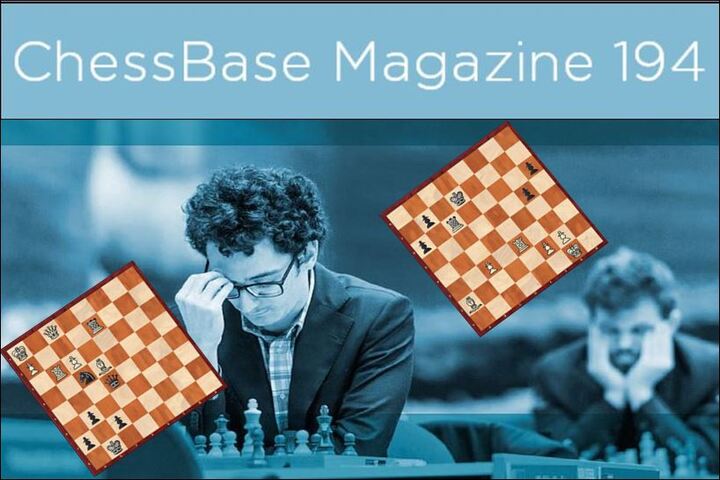ChessBase Magazine 194 a review
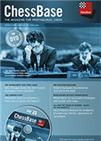 Tata Steel 2020 with analyses by Giri, Firouzja, So, Duda, Navara, Van Foreest and many more. Videos by Daniel King, Mihail Marin and Simon Williams. 11 opening articles with new repertoire ideas and training sessions in strategy, tactics and endgame!
Tata Steel 2020 with analyses by Giri, Firouzja, So, Duda, Navara, Van Foreest and many more. Videos by Daniel King, Mihail Marin and Simon Williams. 11 opening articles with new repertoire ideas and training sessions in strategy, tactics and endgame!One of my usual blitz opponents has made good progress in chess. I won the latest 18 games blitz match against him, but felt the difference (12½ to 5½ for those curious of the result!). I began to probe what he did to improve, and being friendly he told me few of his secrets. He began to do a lot of slow tactics, and follow tournaments trying to guess the move, while listening to the commentary and absorbing the ideas expressed. I thought I would do something similar, but I really don't have time to follow tournaments online. Work, Family etc. totally prevent me from copying that learning style. Luckily ChessBase Magazine comes out every other month with enough material to let me study at my own pace.
This time, when browsing the ChessBase Magazine 194, instead of going for the endgames I went for the complete games. There are 1249 games in this ChessBase Magazine, the number is not really important, what I care to read are the games commented by titled players. There are 30 games annotated by grandmaster. Clicking on the annotator tab, it will re-order the database with the annotated games first.

Pro tip on how to jump straight to the annotated games
The reader now will enjoy a game I added to, keeping the annotations by GM Edouard, and adding mine after "Nastasio:". Please keep in mind you will not improve if you don't interact actively with the games you watch. My friend was guessing the move, I put myself in polemic with the previous annotator. There is no real "offensive" tone against the other annotator, it's just a way to train and improve, because at the board we are challenging our opponent, and the one who has the best idea will prevail. That's why chess is a spiritual game, because it's all inside our heads, it's not really about pushing ugly plastic pieces weekend after weekend.
Often we don't notice the aesthetic work done by the ChessBase team for giving us an innovative product, which is professional, but also pleasant to the eye. I like how each issue has a different color, and the boards too have different colors.
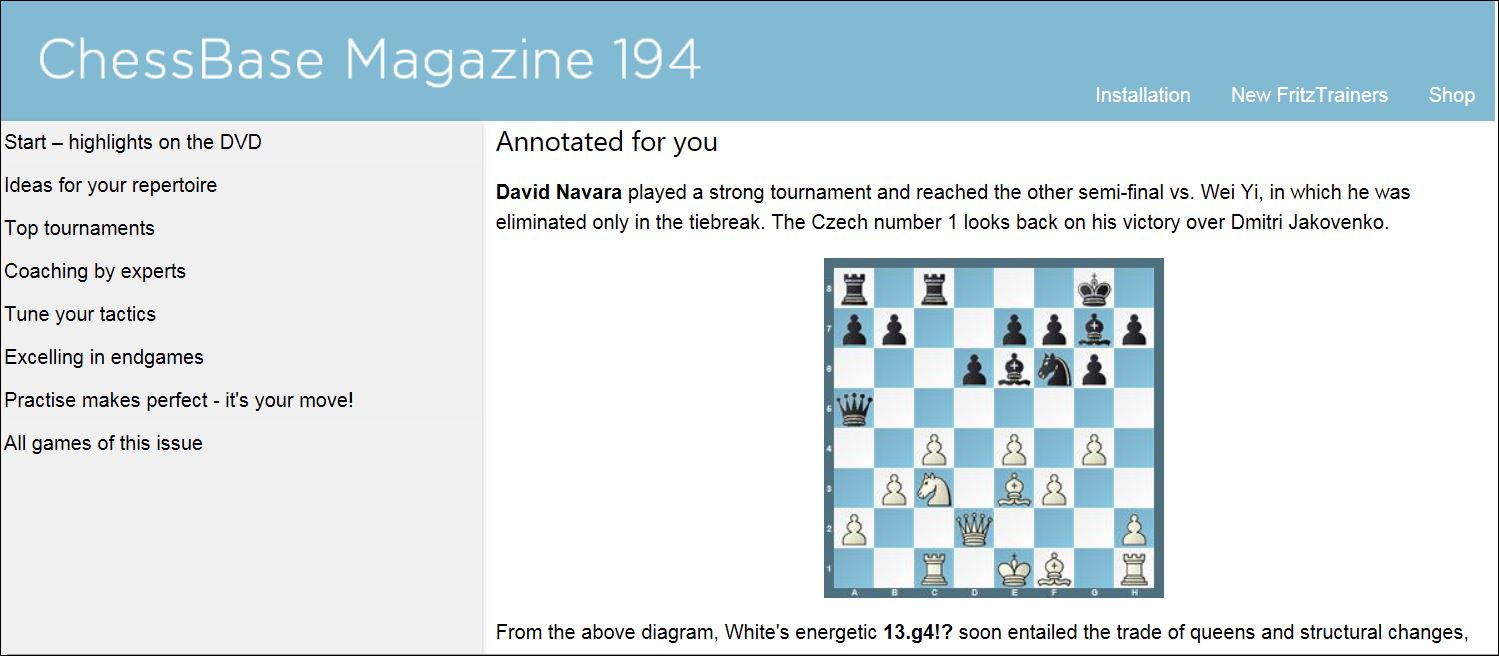
One section which is important is the one about tactics. Of course we have tons of computer-generated tactical positions, taken from games, on the main chess sites. However, on ChessBase Magazine we have IM Oliver Reeh, who selected 30 positions, and asks us questions. This type of exercise is much more valuable than doing random tactics online, because it's the one nearest to tournament play conditions, when depending on our evaluation of the position, we throw ourselves in a possible combination, which in order to be profitable, will need to be converted into a win.
Let me illustrate this idea with a position:
The tactical motif behind this position is quite simple. Yet, for my elementary school students quite difficult to see, and in fact during the game Black, a player rated 2100+ also missed it, vindicating and proving right the many GMs who continue to push and suggest to their students to study tactics. I was giving a lesson on forcing moves, so obviously after the lesson I was showing some positions to some students, in order to make them think. Since I don't believe the parents pay the highly expensive course for us teaching their children how to push plastic pieces, but they pay for us to teach them how to think, and that's what I do.
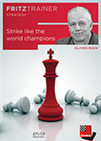 88 times, IM Oliver Reeh leads you step by step through the most brillant game conclusions of the world champions - in interactive Fritztrainer format, enabling you to enter the winning moves yourself.
88 times, IM Oliver Reeh leads you step by step through the most brillant game conclusions of the world champions - in interactive Fritztrainer format, enabling you to enter the winning moves yourself.Since it was difficult for the kids to find the right move, another coach gave as explanation the fact that a kid wouldn't want to give his queen away for something which is not immediately clear.
This is the final position after the combination:
The point here is that one still needs to convert this position into a win, and many don't know how to do that. But this is the big difference with a class which last 1-2 hours a week, and the ChessBase Magazine and relative tools provided. We can practice for each of the positions given by Reeh, in how to convert them into a win. This practice is an invaluable training, because when in tournament we'll find ourselves in need of converting a position in which we have gained a material advantage into a win, we'll know how to do it.
ChessBase Magazine comes out every two months, giving us about 180-200 positions a year. This is like playing 200 tournament games in which we learn how to win, without the pain and hurt which can come out if we lose. Bottom line we'll be more prepared, and less anxious at the board.
Value for money
But if this was all the training ChessBase Magazine can offer, it would be quite small. Instead being an electronic magazine, it comes also with a column dedicated on training, in which strategy, tactics, and endgame positions are proposed to the reader. In this issue there are 52 games with multiple questions. I believe this is really important, because the questions ask to evaluate the position, instead of finding a 3-4 moves combination.
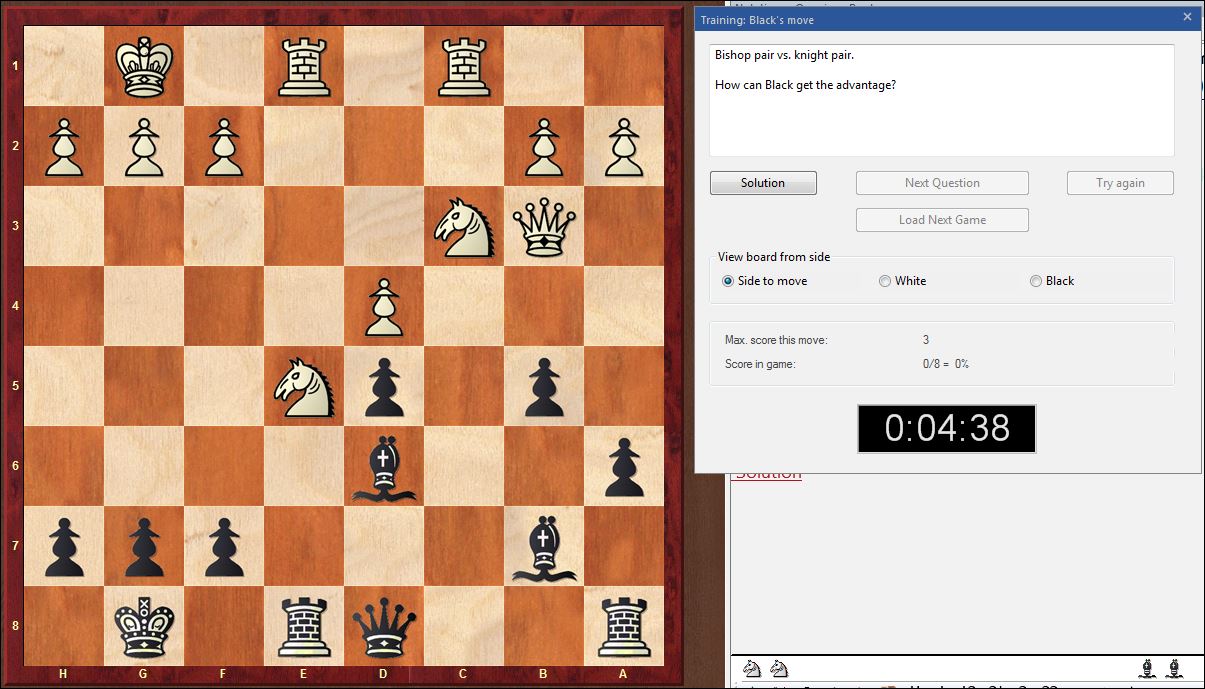
After answering all the questions one has the choice to give a look at the entire game. I find such training good, because it allows me to get an idea from which opening such position originated. In this way I gain a library of patterns and themes which are linked to something real: a tournament game with a specific opening. The advantage is also evident for monetary reasons. If I go to take a lesson with a GM, it may cost me $100 for 1 hour. If the GM shows me some positions, and I take 10 minutes for each, I might have spent that $100 for learning about five positions. Here I have 52 games with multiple questions, which I can solve at my own pace. I can also place them over a real board to better understand the nuances of that position.
I know in modern times to read more than 340 characters can be a painful experience for the eyes, so I'll keep this review short... but there is some content in the ChessBase Magazine which always thrills me. Excelling in Endgames is the column by Karsten Mueller which I always like to pay attention. This issue is dedicated to bishops of the same color. And GM Mueller dedicate the time to explain the Centurini's rule which is important for this type of endgames. But is this the only rule Mueller explains? NO! There is also the Capablanca's rule. I don't know how long Mueller worked for selecting and explaining these positions, I counted 18 and then there are 9 endgame tasks (endgame positions for solving). But I cannot blame anyone else than me, for not improving in chess, because to have a passionate GM explaining endgame after endgame, and focusing my attention on positions I should know, it's definitely a blessing, and I'm quite grateful to Mueller and ChessBase which gives me such high quality teaching for a very low price.
In this position Black can draw, if he knows the Centurini's rule. Try it against the engine, and if you can't draw, when you own your copy of CBM 194, you'll be able to listen to the explanation directly from Mueller's lips!
There are also two videos I don't miss, one made by Simon Williams, in a guess the move format. Williams likes attacking chess, and the game chosen is a king hunt, in which one has to use deep calculation skills. I admit I don't follow much the main tournaments, so often I don't know who are the GMs playing and their styles. But if Williams mentions he likes a certain player, I generally go to see some of his games. In this case the player mentioned is Danil Dubov. In this issue of ChessBase Magazine there are 1249 games, and I selected one from Dubov which I found exciting.
The other video is by GM Rogozenco, a game from classical times, well annotated and explained.
"Chess is a spiritual tool"
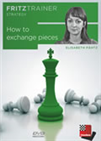 Learn to master the right exchange! Let the German WGM Elisabeth Pähtz show you how to gain a strategic winning position by exchanging pieces of equal value or to safely convert material advantage into a win.
Learn to master the right exchange! Let the German WGM Elisabeth Pähtz show you how to gain a strategic winning position by exchanging pieces of equal value or to safely convert material advantage into a win.
Before I forget, if one is interested in learning German, from ChessBase Magazine 193, it has been given a bonus video with the comment of an interesting game, completely in German! Germany is like Russia a great chess nation, it could be worth to learn some German, visit and play in the myriad of chess clubs they have in Germany. I certainly hope to do so one day. In the magazine is written: "if you understand German fairly well..." I don't , but if one listens actively, he will recognize many words are similar to English, like:
- "beste zug" ("best move")
- "spielen mit" ("play with")
- "ist intuitive" ("is intuitive")
- "ganz formidables"
I could continue to show the phrases I found quite similar to English, but it's clear that any American can understand many words and phrases just paying attention, plus the guy is speaking about chess, and in chess we are talking always about the same stuff, open files, activate the pieces, tactics etc. And watching such video I discovered Elisabeth Paehtz made two DVDs in German on the London system! Again, for me chess is a spiritual tool, something I use to grow as person. So I welcome every chance I have to learn something new, be the German language, or learn a different interpretation of an opening I know thanks to a different titled player.
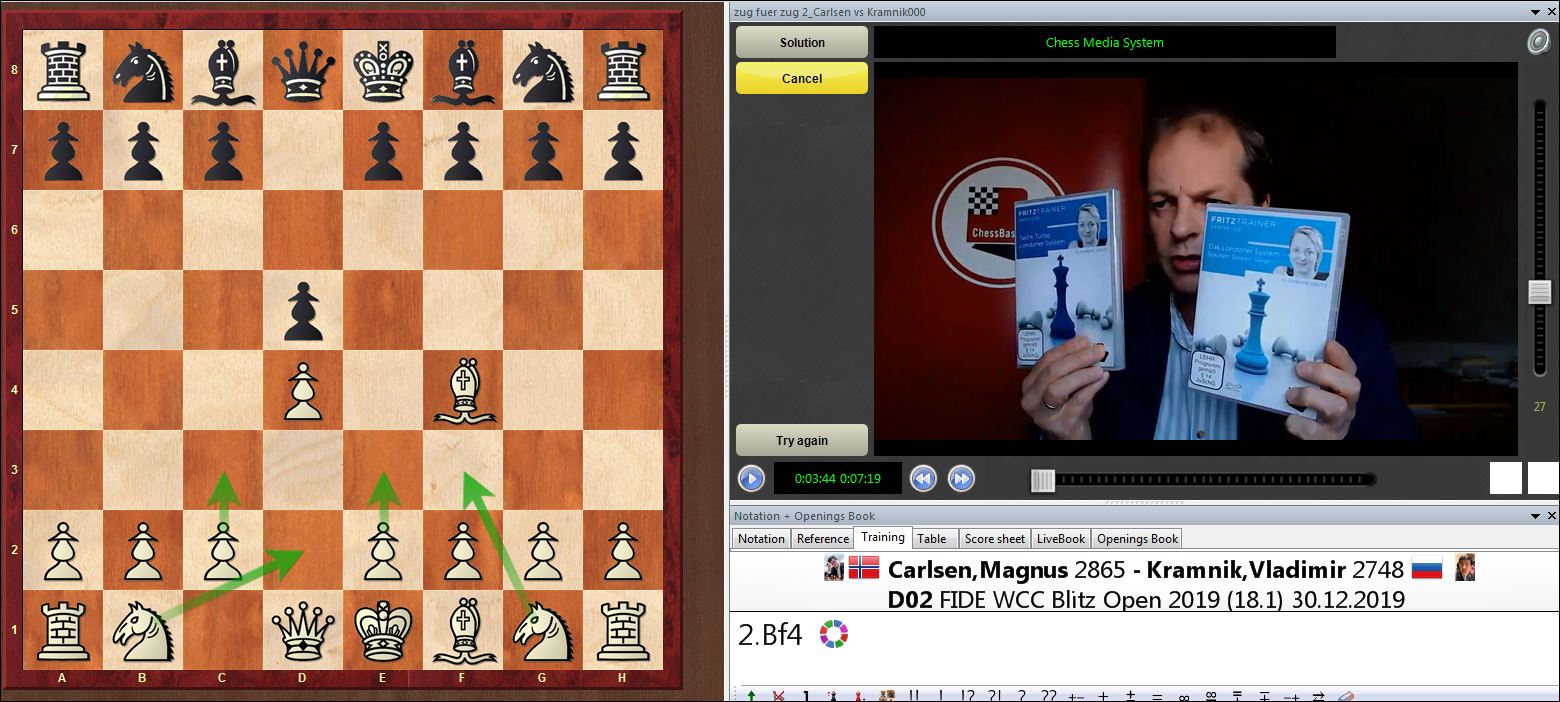
The database of games which comes with this issue of ChessBase Magazine, can be used to peruse the latest novelties in one owns opening repertoire, played at top level, or also to know some players. For example the Candidates' tournament is coming up, and one could be interested in seeing the latest games by each candidate. Caruana, who I favor because I hope he wins the world championship, and eventually leads to a big chess boom in US, had 13 games in this issue, and this is the one I found more interesting:
Pro and Con
As a reviewer I have the terrible task to pick up some small errors to feed the masses. The readers feel betrayed if the reviewer doesn't point out at least one mistake, lest they think the reviewer is a sell-out. I'm ready to be bought, but unfortunately they are not offering, so I have to continue to write reviews and articles! As chess player my goal in reading Chessbase Magazine is to improve my chess, not being part of a grammar police or some kind of correction unit, I find little pleasure in this task, and I wish the readers would grow up, and care more about the content than possible typos, since we are all humans and we make mistakes all the time. However, In the Oliver Reeh column, the second diagram, the White queen is on e3 not on e4.
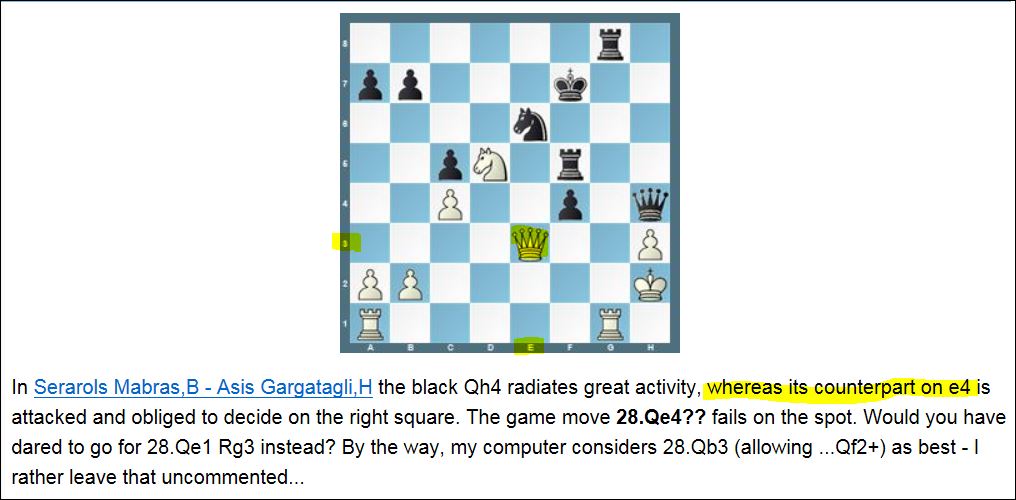
Instead a more important criticism could be issued on the use of small fonts. Let's make 2020 the year in which chess companies begin to use bigger fonts, especially when they are not consuming real ink.

Click or tap to enlarge
Here the questions asked in this exercise are using a very small font. As reader, I wish I could enlarge it, as I do with the text of the game, for which I can decide which font I want to use, but there is not such option.
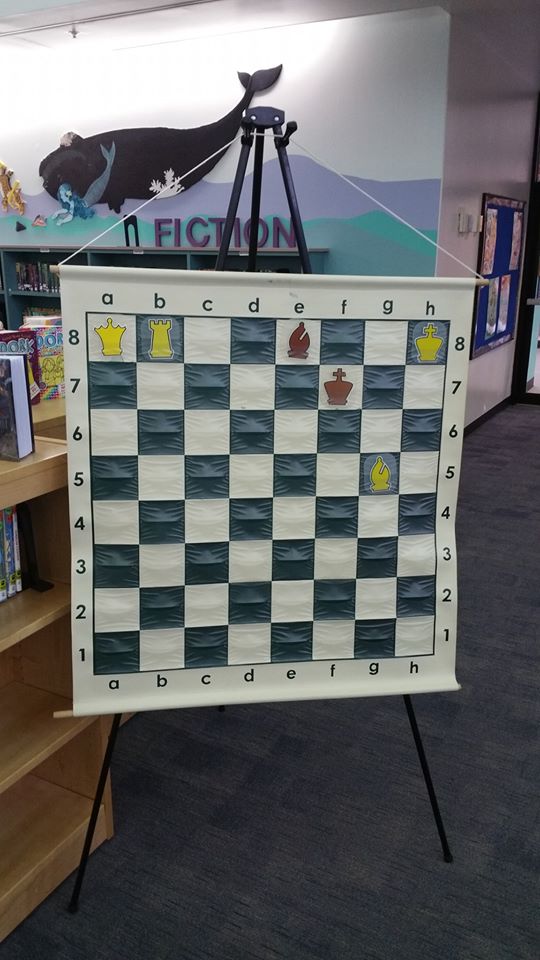
Another criticism could be related to the content. Lately US Chess (The United States Chess Federation) has done a great job in releasing all the issues of their official magazine from the beginning in PDF format. I found myself perusing those magazines, because I began to play around 7-8 years ago, and didn't know what the chess world of the 1940s-50s etc. was like. But what I found interesting was that I found nearly in every issue of Chess Life of those bygone times a section with checkmates in 2-3 moves. Why do I mention it? Because GM Yusupov has created a series of 9 books to bring a player to master level, and also in his books there is a chapter dedicated to the checkmates in 2 moves. Maybe ChessBase Magazine should consider to add a section with checkmates in 2 moves. From what I understood in Yusupov's books, they are excellent in opening our chess minds to different candidate moves, and help us to improve our calculation. Again, my point is always related to my chess improvement, because I have to play tournaments all year long, and whatever can give me a slight edge over the competition is warmly welcomed. While by choice I read only ChessBase Magazine, because I do consider it the best chess magazine in the world! I also know the content of the other chess publications, and one definitely has a study and checkmate columns.
As a parting gift, since the review is ending, In one of the classes I work, one of the coaches presented the following checkmate to the kids. It's a checkmate in 2, obviously White wins by force or with a checkmate in 3 or more moves. But if you are trying to help the kids reason, this will ask them to find the right move and calculate precisely:
Here the diagram for those who'd like to try against the engine:
Final thoughts
ChessBase magazine is a fundamental chess source for those who want to make of chess their lifelong sport. It helps to stimulate our chess knowledge in the different parts of the game. We can use this magazine to prepare for tournaments, or even prepare the students we teach thank to the huge amount of material one can find in it.
Tata Steel 2020 with analyses by Giri, Firouzja, So, Duda, Navara, Van Foreest and many more. Videos by Daniel King, Mihail Marin and Simon Williams. 11 opening articles with new repertoire ideas and training sessions in strategy, tactics and endgame!
Links
